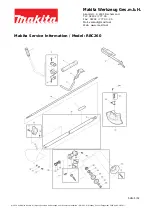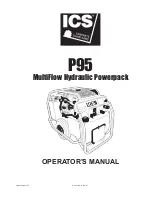
English
6
Accessories
WARNING:
Since accessories, other than those
offered by CRAFTSMAN,
have not been tested with
this product, use of such accessories with this tool
could be hazardous. To reduce the risk of injury, only
CRAFTSMAN recommended accessories should be
used with this product.
Recommended accessories for use with your tool are
available at extra cost from your local dealer or authorized
service center. If you need assistance in locating any
accessory, please contact CRAFTSMAN, call
1-888-331-4569
.
MAINTENANCE
WARNING: To reduce the risk of serious personal
injury, turn unit off and disconnect it from
power source before making any adjustments or
removing/installing attachments or accessories.
An accidental start-up can cause injury.
supply, it will start immediately. Damage to your tool
or personal injury may result.
This jig saw is equipped with four cutting actions, three
orbital and one straight. Orbital action has a more
aggressive blade motion and is designed for cutting in soft
materials like wood or plastic. Orbital action provides a faster
cut, but with a less smooth cut across the material. In orbital
action, the blade moves forward during the cutting stroke in
addition to the up and down motion.
nOTE:
Metal or hardwoods should never be cut in
orbital action.
To Adjust the Cutting Action
• Move the cutting action lever
8
between the four
cutting positions: 0, 1, 2, and 3. Position 0 is straight
cutting. Positions 1, 2, and 3 are orbital cutting. The
aggressiveness of the cut increases as the lever is
adjusted from one to three, with three being the most
aggressive cut.
Fig. G
8
Hints for Optimum Use
Tips for sawing laminates
• As the saw blade cuts on the upward stroke, splintering
may occur on the surface closest to the shoe plate.
• Use a fine-tooth saw blade.
• Saw from the back surface of the workpiece.
• To minimize splintering, clamp a piece of scrap wood
or hardboard to both sides of the workpiece and saw
through this sandwich.
Tips for sawing Metal
• Be aware that sawing metal takes much more time than
sawing wood.
• Use a saw blade suitable for sawing metal.
• When cutting thin metal, clamp a piece of scrap wood
to the back surface of the workpiece and cut through
this sandwich.
• Spread a film of oil along the intended line of cut for
easier operation and longer blade life. For cutting
aluminum, kerosene is preferred.
Pocket Cutting (Fig. H, I)
A pocket cut is an easy method of making an inside cut.
The saw can be inserted directly into a panel or board
without first drilling a lead or pilot hole. In pocket cutting,
measure the surface to be cut and mark clearly with a
pencil. Next tip the saw forward until the front end of the
shoe sits firmly on the work surface and the blade clears the
work through its full stroke. Switch the tool on and allow
it to attain maximum speed. Grip the saw firmly and lower
the back edge of tool slowly until the blade reaches its
complete depth. Hold the shoe flat against the wood and
begin cutting. Do not remove blade from cut while it is still
moving. Blade must come to a complete stop.
Fig. H
Fig. I
Versatrack Variables
1ST_Figure
1ST_Callout
2ND_Callout
J
14
7









































